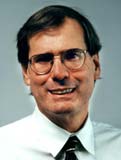
This is a big, big deal that Siler is pushing for as a relatively recent part of his decades-long, multi-disciplinary quest to discover more about mind and matter. The vision is to capture carbon dioxide from thin air as well as from sources emitting it as waste. Any endangering greenhouse gas effects would thereby be negated as the CO2 was converted into a fuel itself providing recyclable emissions. It could then supplement other renewables and coal, oil and gas in keeping our industrial civilization humming happily along.
This approach gets more than a little boost in the University of Colorado Art Museum in Boulder. That's where Siler and I walked around inside a 145-foot long, 11-foot wide representation of a brain's crucial limbic system. Siler, a Colorado author and inventor on top of being an artist of widely recognized merit, was the creator of this amazing work of educational art. Siler himself was amazing, a human source of energy that inspirits you as he talks of how we use our intellects to transform what nature gives us to something new we need.
As we surveyed this display and then other dazzling shapes and colors focused on the CO2 scheme, he further explained that first we connect with nature, then discover concepts, then invent and then apply, and I asked if he meant first we see a tree, then figure out some things about wood, invent planks and build a house. I think he thought I was getting it.
His chief reference on this day, however, was to the conversion of CO2 to fuel by a process that imitates what photosynthetic plant leaves do when they use sunlight to produce energy. Someone busily figuring this out is Geoffrey Ozin, a nanochemist. He is Siler's scientific confederate, a Canadian who met Siler when both were being honored at a 2011 World Cultural Council ceremony in Estonia. He has been counting on Siler to help get complex ideas across to the public through his astounding art.
Ozin refers to these complex ideas being addressed by him and a group of some 30 other scientists at the University of Toronto as Plan B, an alternative to the primary solution being offered as an answer to climate change concerns. In an email exchange, he seemed fairly confident that some such Plan B will prove itself out of the half dozen or more similar theories now being explored around the world, and it seems to me hugely important that this happens.
The primary solution being talked about is a global effort to limit CO2 emissions through fossil fuel restrictions out of a fear that global warming will otherwise do horrible harm. Some critics argue more harm would come from weakening economies because of less energy, that we humans can adjust to more warmth if necessary and that solar and wind power will never make up for the fossil fuel energy depletion. A workable Plan B could someday — if not for some years — take away any manmade warming threat and give us all the energy we could possibly need.
I choose to be hopeful about the near term and long term. As Siler and I were leaving the museum, we noticed some schoolchildren sitting in a circle on the floor and looking at his limbic system portrayal. I could not help but think some just might be asking themselves large questions of the kind Siler asked himself when he was 12 and that they then might aim to enlarge human possibilities themselves someday.
Jay Ambrose
(TNS)
Comment by clicking here.
Jay Ambrose, formerly Washington director of editorial policy for Scripps Howard newspapers and the editor of dailies in El Paso, Texas, and Denver, is a columnist living in Colorado.



 Contact The Editor
Contact The Editor
 Articles By This Author
Articles By This Author